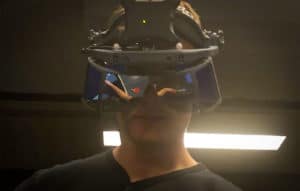
If you wanted to demonstrate Leap Motion’s low-cost augmented reality headset, how would you do it? Create a flashy, action-packed showcase? Leap Motion has a different idea: an invigorating game of ping pong. The company has crafted a demo that combines the Project North Star headgear with paddle controllers to pit the wearer against an AI opponent at a real ping pong table. It’s not mind boggling by any stretch, but it’s a good example of a fast, intuitive AR experience that depends on high accuracy. You can juggle the ball and serve it as naturally as you would if it were real. And importantly, there are behind-the-scenes developments that could influence AR going forward.
Leap Motion’s AI opponent determines where it should position itself based on the same action-and-reaction logic used to determine the trajectory of the ball from your own paddle, and has to create a motion path to reach that new position. In other words, the AI paddle has to move more like you do — it can’t just warp to where it needs to be. You can dial it down to accommodate rookies or make it more difficult for experienced players, too. This is a game where the physical nature of AR dictates how the computer player responds, making it more accessible to people who might be frustrated if the AI was free of physical limitations.
You might not try this AR table tennis for a long while, if at all, since it depends on companies building headsets around Project North Star’s open-source design. Still, it shows that an affordable AR headset doesn’t have to represent a major compromise in quality compared to its more expensive rivals.
This article originally appeared on Engadget.


